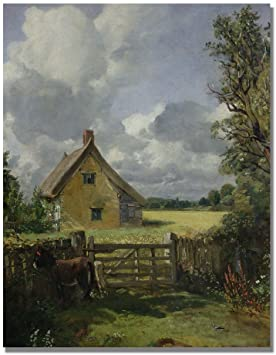John Constable is most famous for being the painter that revolutionized landscape painting. John was born in June 1776 and died in March 1837 in London. John Constable’s paintings that are among the most famous were paintings of the English countryside. His favorite object of depiction was the valley of the River Stour.
John Constable was the son of a wealthy merchant who had great possessions. He was raised in the small town of Suffolk. In most of the painter’s work, the environment he grew up in features prominently. His understanding of the rural economy of Suffolk has also featured in his works; John treasured his hometown and experiences while growing up.
After meeting the famed connoisseur Sir George Beaumont in 1795 and then a group of antiquarians and art experts in Edmonton in 1796, Constable was motivated to pursue art.
In this article, we examine five different exciting facts about painter John Constable’s life who did a lot of much-acclaimed work in the 19th century.
Table of Contents
He Never Traveled Abroad Or Studied With Other Artists
Constable never traveled abroad or studied with other artists. Although he did travel around England, Constable never left the country for any time. His longest journey was a three-month tour to France in 1816.
Although Constable was an autodidact (a self-taught artist), he learned from his landscape paintings and became one of the most remarkable landscape painters in history. He painted many scenes of the English countryside during his lifetime, most notably those depicting Suffolk landscapes and landscapes along the River Stour near Flatford Mill. He lived until 1825, when he sold it to Thomas Monro.
His Father Wanted Him To Be A Lawyer
It’s hard to imagine a world without John Constable, but he came close to not being a painter. Instead, his father wanted him to be a lawyer when he was young. Constable went along with this plan for as long as possible before finally convincing his father that art training would be more practical because it wouldn’t require much studying.
His father wasn’t pleased with this choice of career path, but later on, he said: “You are doing what you like most.” Thankfully, the painter John Constable made the right choice because the world would have been robbed of his unique talents if he decided to do his father’s bidding other than follow his passions.
He Married Maria Bicknell
After meeting at the age of 13 and marrying at the age of 28, you might think that John Constable and Maria Bicknell had a long romance. But no! The couple had only nine years together before Maria died of tuberculosis in 1831.
After their first child was born, Constable wrote to his friend Charles Eastlake: “I have been married three weeks last Tuesday—and am as well as could be expected… I am thrilled with my wife.” Their eldest son survived only two years after being born; they went on to have six other children who lived into adulthood (you can see their portrait here).
John and Maria had seven children, but only one son survived infancy. John Charles became a painter, specializing in miniature portraits of animals. He also developed an interest in marine painting, which was popular. Lionel’s daughter Isabel married a painter named Robert Dawson Jarvis (1825-1906), a student of John Constable’s work.
He Painted in Romantic Style
If you’re a fan of John Constable and his work, the Romantic painting style will likely come as no surprise. He was a Romantic painter who focused on landscapes and was heavily influenced by JMW Turner’s work. Constable and Turner were contemporaries (Turner was born two years earlier than Constable).
Both artists painted in the British Isles, particularly Devon and Surrey. They both used light, shadow, and color to create an atmospheric effect in their paintings while also using painterly brushwork to depict nature as they saw it.
Constable learned from Turner at an early age because he lived near him in London at 5 Suffolk Street, where he spent time sketching with other artists as well as visiting exhibitions at The Royal Academy – where he could see both Turner’s works as well as those by other artists who shared his style such as Gainsborough or Constable artist himself!
His Art Was Unique And Not Popular Initially
Constable is often associated with Romanticism due to his use of light and scenery in his paintings, such as “The Cornfield” (1826). However, he did not consider himself part of any particular school or movement; instead, he preferred to paint landscapes based on what was around him rather than follow trends or try something new.
John Constable was influenced by Dutch landscape art, and his early paintings were landscapes. He was also influenced by Claude Lorrain, who was known for his atmospheric landscape paintings. Constable’s work is more representative than Turner’s, consisting of scenes he saw from his window. One of John Constable’s paintings was 5×6 feet. It was called The Hay Wain, and it’s considered one of the top 10 most recognizable paintings in the world.
In 1821, Constable began painting a series depicting different views of Salisbury Cathedral from various angles. He wanted to paint every possible picture from every angle that you could see from its location on a hilltop that clearly overlooks the city below. The cathedral’s tower stood 150 meters (492 ft) tall at its highest point, so he had some work ahead of him!
Conclusion
John Constable was an artist who created many works of landscape art. Although John Constable was not a good student at school, he loved to draw and paint from an early age. The entire world is grateful that this great painter came to live and fulfilled his dream, influencing many others to excel in their art.










